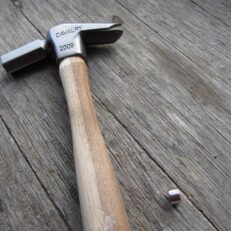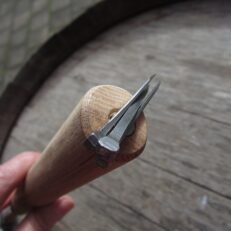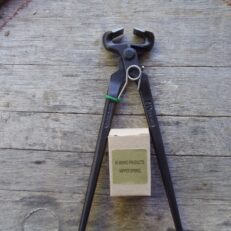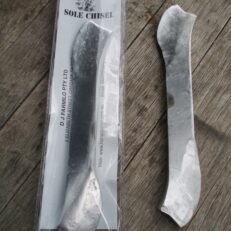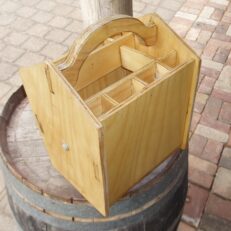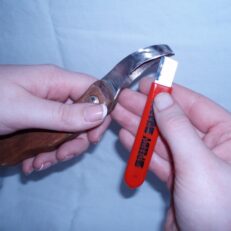Participants on my courses arrive very confused about what tools they should use, and also arrive with an amazing variety of tools. Claw hammers are carpenters tools and are not suitable for shoeing horses. Farriers’ tools are available in a huge range of prices. The old adage that you get what you pay for is very true, but perspective on how much use that tool will receive needs to be kept in mind.
If you are only ever intending to trim, then buy the best quality rasp available, and buy a handle with it. A lot of people don’t realise that rasps can be sharpened up to 10 or 12 times; you can even do it yourself. To sharpen your own rasps, make a 100mm PVC cylinder the same length as the rasp with a PVC cap screwed onto the bottom. Place blunt rasps in the cylinder with handle end upwards, then fill the tube with neat hydrochloric acid, leave uncovered in a well ventilated space for four to six hours, remove and wash in bicarbonate of soda and water solution to neutralise the acid, dry the rasps and spray with WD40 or similar. Make sure to observe the safety regulations for the acid.
Buy a pair of nippers in the middle price bracket. The length of the nippers depends on the span of your hands. Better leverage is obtained with 16” nippers, but a person with small hands may better off with 12” nippers. A nipper spring (available on my website) is excellent for nippers with no return spring.
Hoof knives are available from around $35. Keep it sharp and it will do a better job. But if you have $120 to spend on a good quality loop knife, your job will be so much easier. Always use a hoof knife or loop knife by cutting from the frog down to the toe or from the frog out to the sides; that way you will not cut the frog and most importantly you will not risk cutting the veins and arteries in your arm if the horse moves.
You need to sharpen hoof knives and sole knives to make your job as easy as possible – I promote the Speedy Sharpener (available on my website) which sharpens any type of hoof knife.
Sole Chisels are not available commercially to my knowledge, but I make my own. It makes the job easier when confronted with a horse with a rock hard overgrown sole. You can order one from me or make your own.
Farriers’ aprons are to protect your legs as well as your jeans, so don’t ever do the job without one. But do try it on and walk around in it before you buy it – points to look for are ease of securing the apron, length of the apron (I am tall but I like short aprons, some people like their aprons to ankle length), weight of apron on your body, weight of apron in relation to climate (leather aprons with light weight waist areas are now available and certainly keep the body temperature down).
Also needed for shoeing or just to be able to remove a dislodged shoe before the farrier gets there you will need a buffer for un-clinching the nail, a nail puller for removing the faulty nail, and a shoe puller for lifting off the shoe.
Having outlaid money on farriers’ tools, look after them. Don’t use nippers to remove nails – it will chip the blade. Don’t use the hammer for carpentry. Ideally use a farriers’ tool box – it keeps the tools in order, and it is easier to reach down to a box than to reach right down to the ground for a tool on a tool roll. I have a free design for a lightweight plywood toolbox on my website if you want to make your own or I sell the toolboxes on my website.
Keep a large magnet in the tool box, flick the discarded clinches into the box and they are out of harms way. Anyone who discards nails onto the ground should not be around horses. A magnet in the end of the hammer handle is great for retrieving stray nails and yes I sell them on my website along with larger magnets to screw onto tool boxes to hold the next six nails or any metal tool.
If you own horses, you should always have on hand some purple spray or iodine, and at least one Animal Lintex Poultice and a roll of two inch Elastoplast. People ringing me with a problem are often daunted when I tell them to immediately apply a poultice, but it is no big deal and any horse owner can do it.
If your horse gets a sole puncture or bleeds from the hoof for whatever reason, dirt going into the puncture will immediately result in infection and possible abscessing. Wash the hoof, spray with purple spray or iodine, then soak the Animal Lintex Poultice in cold water and put onto the sole with the plastic facing outwards. Spread the edges of the poultice up the hoof, then use the whole roll of Elastoplast to hold the poultice in place, wrapping around and around the hoof. Yes it will stick to itself, despite the wetness of the poultice.
One little treasure for the tool box is a plastic fancy butterfly clip – the type women use in their hair. If you have a horse that continually swishes its tail while trimming or shoeing, put the clip in the hair on the top of the tail and behold! No more swishing. I shod a horse recently that got tired of not being able to swish its tail, so it carefully backed itself into the wall and knocked the clip off.

